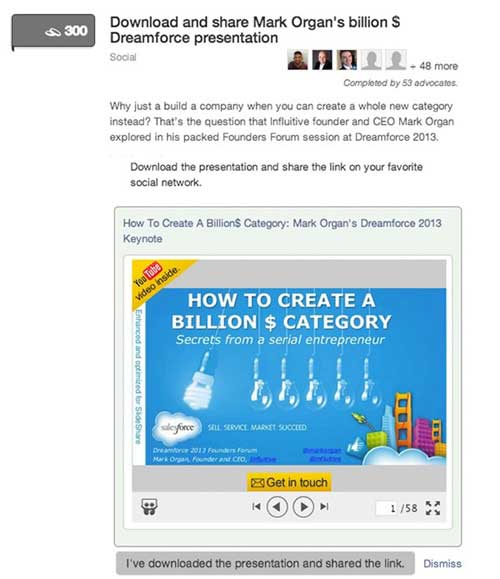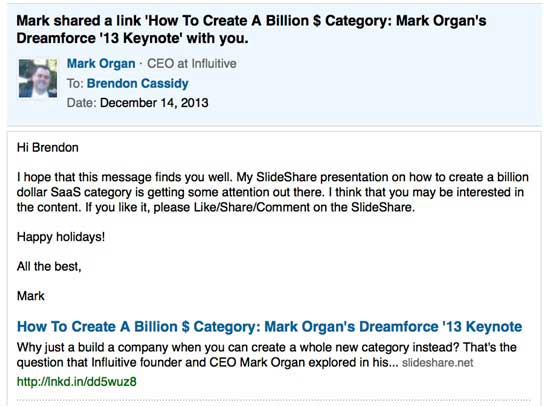Conventional wisdom has it that B2B content is workman-like: stolid, dependable, and certainly not as sexy as its B2C counterpart.
Looking at some of the most viral content from the past year, it's decidedly consumer-facing: Grumpy Cat. Miley Cyrus "twerking" at the MTV Video Awards. Ylvis' "What Does the Fox Say" video.
So is it possible to make our B2B content twerk, not just work?
Some B2B companies have managed to adapt viral memes in their marketing campaigns, but it can be difficult to understand exactly what "viral" means in B2B marketing. Furthermore, it's tempting to associate virality with frivolity.
Look a bit deeper and it's clear that viral content can translate into low-cost leads. Every person who reads, watches, or downloads your content may be a qualified lead at some point.
Viral content also allows us to influence others with tremendous effectiveness thanks to the inherent social proof embedded in sharing behavior.
Despite conventional wisdom, orchestrating virality is possible, to an extent. B2B marketers must first understand the answers to three very important questions:
- How do we create material that encourages widespread and inexpensive distribution?
- What does going viral with B2B content look like?
- How do we "twerk" that content so it can achieve its full viral potential?
The STEPPS framework created by Wharton school professor Jonah Berger, author of the best-selling book Contagious, outlines the six key elements that drive people to share. They include social currency, emotion, being "public," and providing others with information they can use.
Each of those is vital for B2B marketers operating in a world where their buyers are bombarded by thousands of online messages, status updates, tweets, images, emails, and more every day, both as consumers and as professionals.
Is it enough to overwhelm the market with an enormous tidal wave of sharing? If 10 million people shared your content, it would be exhilarating, exciting, and great for your ego... sure. But would it generate more high-quality leads and, ultimately, revenue for your company? That depends.
Perhaps "going viral" in B2B requires a few caveats:
- The right people shared it...
- With the most relevant people in their networks...
- Through the most appropriate medium...
- At the best time of day.
We at Influitive have been experimenting with a similar viral strategy. Our goal was to expand the reach of "How to Build a Billion $ Category," my Dreamforce 2013 Founders Forum presentation slides, which we both updated with new content that wasn't in the original presentation and optimized for SlideShare.
Since first released in early December, it has been featured on the SlideShare homepage and in the "Hot On Twitter" section, tweeted by @SlideShare and hundreds of others, downloaded more than 130 times, and embedded in a news article. As of the writing of this post, it has been viewed well over 12,000 times, and liked over 150 times on SlideShare and LinkedIn.
It has taken off.
That's why I wanted to share some of the insight we've gathered over the past weeks in the hopes of helping you empower your own advocates and influencers to make content go viral.
Here's how anyone can "twerk" their content.
1. Design the content for maximum sharing
People aren't going to share something they don't absolutely love, or find useful for either themselves or their networks. They want to prove that they're in the know; your content should help them do that.
My presentation was designed to appeal to a wide range of people, from other entrepreneurs to VCs to marketers (including Influitive's customers) and more. It contained information and insight most of them probably had not seen before. As an augmentation of an actual Dreamforce presentation, it was also authentic in ways that the commonplace "top X ways to do Y" SlideShare formats seem ersatz.
Like a Bollywood movie format, which has a "masala"' of singing, dancing, romantic plot with action, the presentation has a personal story, a framework for how to think about categories, some compelling data on the value of category creation, and some practical steps driven from my personal experience.
I made a conscious effort to incorporate several of Berger's STEPPS to create buzz:
- Story: My personal and authentic story of where the ideas for my companies, Eloqua and Influitive, came from.
- Trigger, Public: When readers hear public mentions of a "billion-dollar category," word association triggers sharing.
- Social Currency: Many entrepreneurs, investors, and marketing leaders want to be known as people interested in building billion-dollar categories.
- Practical Value: This is relevant content for anyone seeking to build a category.







